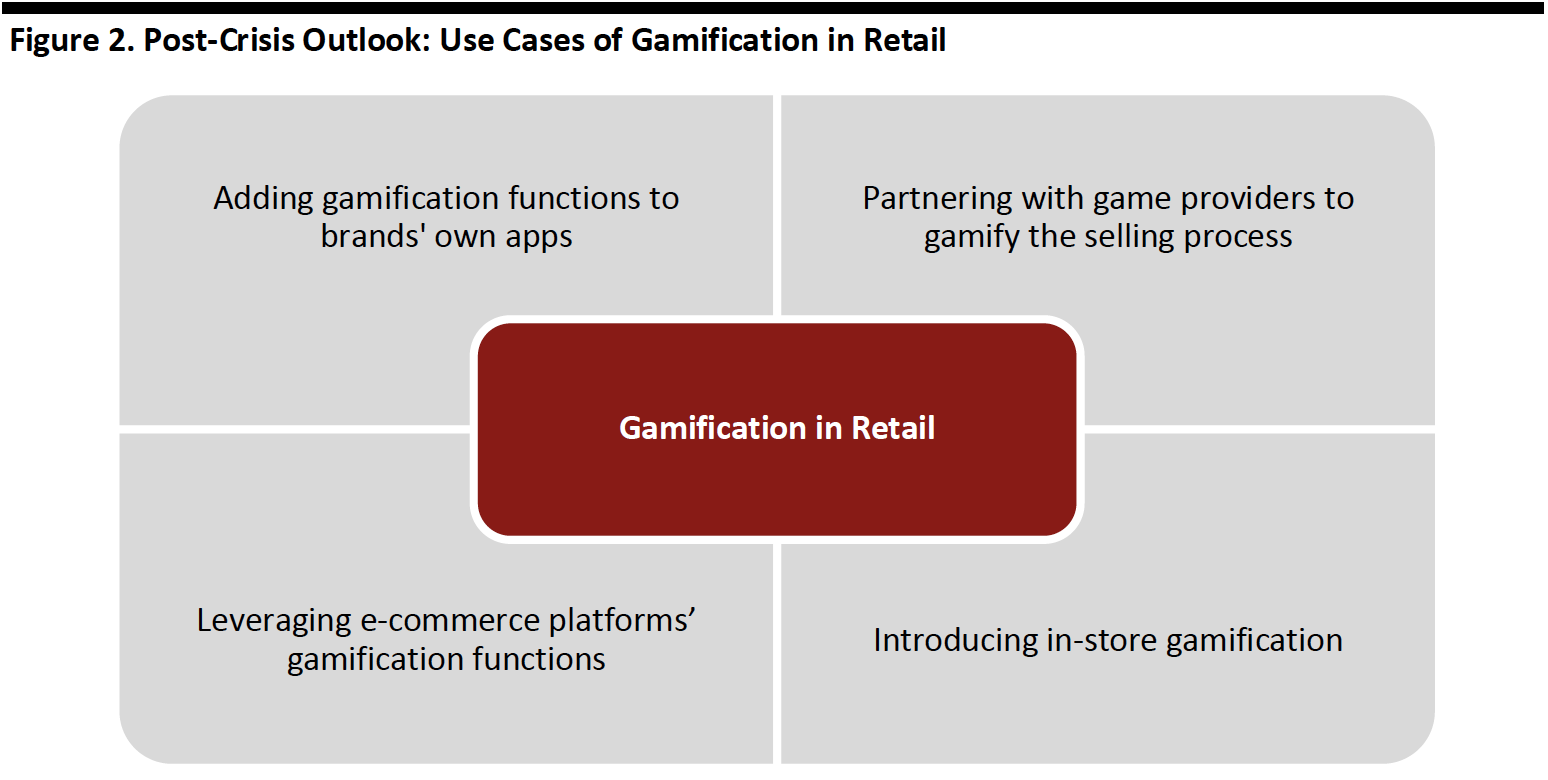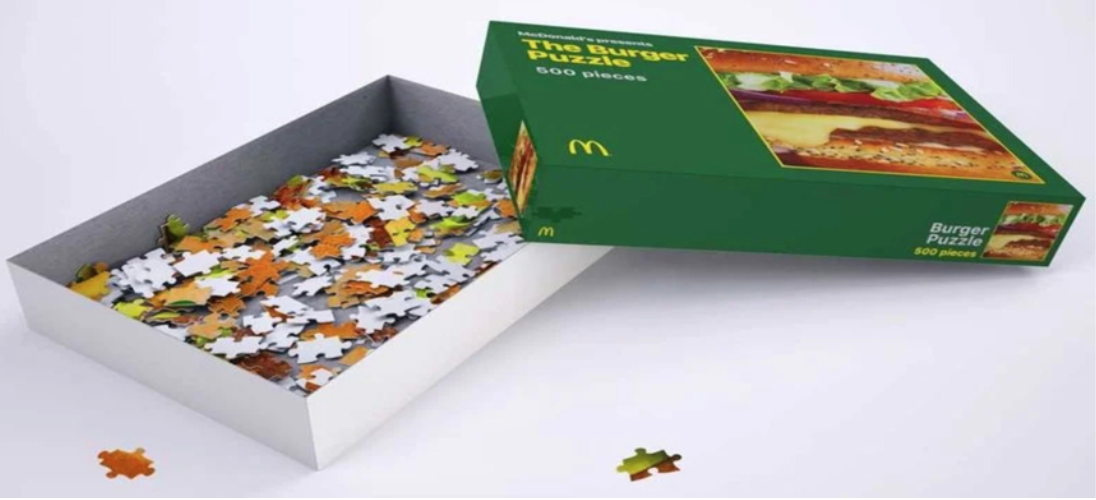
albert Chan
What’s the Story?
Covid-19 has changed consumer behaviors, and retailers and brands have had to actively respond to these shifts—impacting how they operate and prompting retail firms to be more agile and adopt new channels, services and ways of selling. In our Retail Reimagined series, we offer a thematic outlook to the post-crisis world, identifying and discussing key retail trends that are likely to prevail and exploring how retail may be reimagined in response to shifts in demand and supply.
[caption id="attachment_113523" align="aligncenter" width="700"] Source: Coresight Research[/caption]
Source: Coresight Research[/caption]
In our first Retail Reimagined report, we consider how brands and retailers can leverage various gamification techniques to engage with consumers through the shopping process, thus enhancing sales potential, brand awareness and customer loyalty.
Why It Matters: The Rise of Gamification
The coronavirus pandemic has significantly impacted the ways in which consumers engage in retail, such as an increased desire to be entertained via digital means amid widespread temporary store closures. With consumers spending more time at home and using screens, brands and retailers were presented with an opportunity to attract shoppers digitally by gamifying the shopping process to provide engaging experiences. In a post-crisis world, we expect the adoption of such techniques in retail to continue.
The global gamification market is projected to reach $40 billion by 2024, representing an impressive CAGR of 32% from 2018, according to TechSci. This estimate covers gamification in different industries, such as retail, education and banking.
Looking Beyond the Crisis
In the post-crisis world, we expect that gamification that helps brands and retailers to establish a rapport with customers will gain more traction. Gamification can be adopted in various ways, as we outline in Figure 2 and discuss below.
[caption id="attachment_113163" align="aligncenter" width="700"] Source: Coresight Research[/caption]
Source: Coresight Research[/caption]
Adding Gamification Functions to Brands’ Own Apps
Brands and retailers can add gamification features within their digital apps to engage with consumers. Apps with gamification elements enable customers to experience the brand’s products and services in a fun way, thus enhancing their relationship with that brand.
In order to identify the gamification elements most suited to their customer base, brands should first look to analyze the needs and traits of their different shoppers, such as through purchasing data. By determining key customer information, companies can develop customized games to enhance their effectiveness.
The advantages of app gamification partially lie in the portability, convenience and popularity of mobile devices. Users can easily enjoy fun brand experiences via their mobile devices anywhere at any time. The number of mobile devices worldwide is estimated to reach 16.8 billion in 2023, representing 28.3% growth from 13.1 billion in 2019, according to Statista.
Partnering with Game Providers To Gamify the Selling Process
Retailers and brands could partner with game providers to gamify the process of selling their products. Gamification vendors such as Badgeville, BigDoor Media and Bunchball use application programming interfaces in websites and mobile apps to add an interactive game layer—meaning that retailers would not need to change their systems to incorporate gaming elements, as it would be an additional component.
Brands would also be able to leverage gamification providers’ data to gain a deeper understanding of consumer behaviour, which they could use to adjust product designs and marketing approaches. Gamification providers could track consumer engagement data to measure the effectiveness of games and provide insights into how brands could better interact with their customers.
Leveraging E-Commerce Platforms’ Gamification Functions
Brands and retailers could work with e-commerce platforms that adopt gamification to entertain users and increase user stickiness. Giving consumers the chance to win prizes—such as exclusive discounts—helps to build a sense of added value.
In the face of fierce competition among e-commerce platforms, it has become more costly for them to gain new customers. We therefore expect e-commerce platforms to expand their customer base by further leveraging consumers’ social networks via gamification—for example, encouraging consumers to share product links with their contacts through prize-yielding games (with prizes including product discounts). We have seen Chinese social commerce platform Pinduoduo use this technique to achieve meaningful reductions in the cost of customer acquisition: In the June quarter of 2019, Pinduoduo spent around ¥153 ($22) per acquired customer, compared to JD.com’s ¥520 (around $74.80) and Alibaba’s ¥535 (around $76.90). (This period represented the second quarter of 2019 for Pinduoduo and JD.com, and the first quarter of the fiscal year for Alibaba.)
We expect that e-commerce platforms will further enable the seamless integration of gamification and social media. Providing shareable content as part of the gaming process enables users to invite their contacts to participate in the game, expanding consumer reach and brand awareness. For instance, Singaporean e-commerce platform Shopee hosts a number of shareable games—Shopee Catch, Shopee Shake, Shoppe Slice and Spin & Win. These games drove 150 million clicks on the Shopee platform within three weeks during the Singles’ Day 2019 promotion period and increased the duration of browsing on the platform, according to the company.
Introducing In-Store Gamification
Brands and retailers can introduce gamification into their physical retail stores by launching game formats—these can increase the time consumers spend in a store as well as attracting more new and repeat customers, growing brand awareness and speeding up the process of customer acquisition.
We foresee the future of in-store games as beyond simply encouraging customers to participate in play revolving around the brands’ products: It will be gaming that connects consumers across all touchpoints in store, which will make the whole shopping journey a fun and engaging experience for the consumer.
We expect advancements in technology to further accelerate the introduction of gamification in brick-and-mortar stores. For instance, augmented reality technology can enhance the dressing-room experience in a clothing store, allowing shoppers to view apparel and receive recommendations, helping them to feel more confident in buying.
Gamification amid the Covid-19 Crisis
There was a clear uptick in the use of gaming by consumers during the coronavirus pandemic. Globally, around 82% of consumers played video games and watched video-game content during lockdowns, according to Nielsen: Daily viewership on Twitch—a popular online streaming platform for esports—increased from 13 million on January 1, 2020 to 31 million on March 28.
Capitalizing on the trend of consumers spending more time on their screens and engaging in games, a number of brands and retailers have adopted gamification to connect with consumers amid the crisis. Below, we highlight some of the recent innovations.
Drest Sees Increased Installs
Drest is a fashion styling gaming app through which users can dress model avatars in styling challenges. Users can then buy the designer clothes featured in the game on e-commerce platform Farfetch. More consumers turned to Drest to engage in fashion and personal creativity during the pandemic: The app saw a 50% month-over-month increase in installs during the pandemic, as of mid-April. In Italy, it saw 400% growth during the first week of April, compared to the prior week.
[caption id="attachment_113165" align="aligncenter" width="550"] Source: Company website[/caption]
Source: Company website[/caption]
McDonald’s and Kraft Heinz Give Away Puzzles
McDonald’s and Kraft Heinz Canada released separate branded jigsaw puzzles to entertain consumers at home amid the pandemic. McDonald’s cooperated with advertising firm TBWA to create a 500-piece burger puzzle, and the fast-food chain gave away 20 puzzles through an Instagram contest.
[caption id="attachment_113166" align="aligncenter" width="550"] McDonald’s The Burger Puzzle
McDonald’s The Burger PuzzleSource: Company website[/caption]
Kraft Heinz created “the world's slowest puzzle,” which contains 570 pieces identically colored in the ketchup brand's signature red hue. The company released 57 versions of the puzzle for consumers in 17 countries, and launched a product giveaway through social media in Canada.
[caption id="attachment_113167" align="aligncenter" width="550"] Kraft Heinz Canada puzzle
Kraft Heinz Canada puzzleSource: Company website[/caption]
Pinduoduo’s Game Boosts Sales of Agricultural Products
Pinduoduo’s gaming feature, Duoduoguoyuan (translated as “Duoduo Orchard”), helped the platform to sell agricultural products during the pandemic. The game required users to log into the app for seven consecutive days to carry out various digital gardening tasks, such as watering plants, for the chance to win 1kg of fruit—which Pinduoduo had bought from local farmers. The game also features in-app purchases. Agricultural products grown from Meihekou, a city in Jilin, saw sales reach ¥1 million (around $142,379) on April 17, 2020.
[caption id="attachment_113170" align="aligncenter" width="330"] Duoduo Orchard
Duoduo OrchardSource: Company website[/caption]
Burberry Introduces an In-Store Game To Engage with Consumers
Burberry’s first online game, B Bounce, was made available for consumers to play on a large screen in Burberry’s flagship store on Regent Street in London in October 2019. The retailer’s aim was to better engage with consumers by bringing the gaming experience to them.
In the online game, consumers race a deer-shaped character to the moon—users choose a Thomas Burberry monogram puffer jacket for the character to wear to start its journey, and then they can gain extra speed by adding Burberry’s gold TB logos and drones along the way.
Prizes include tailormade GIFs featuring virtual Burberry puffer jackets. A real jacket from the new Burberry puffer collection was made as the first-place prize for game competitors in Canada, China, Japan, Korea, the UK and the US.
[caption id="attachment_113171" align="aligncenter" width="330"] Source: Company website[/caption]
Source: Company website[/caption]
What We Think
We expect that marketing activities that introduce fun elements for consumers will play a significant role in brand engagement moving forward—building on retail’s increased reliance on digital channels amid Covid-19. Gamification will help brands and retailers to establish better rapport with consumers, as well as increase brand awareness, customer loyalty and profitability.
Implications for Brands and Retailers
Brands and retailers could adopt gamification in various ways through the shopping process, such as via the following:
- Launching in-app gamification features to enable users to play while they shop
- Partnering with e-commerce platforms that have gamification functions
- Introducing games into offline retail stores
Implications for Technology Vendors
Technology vendors could look to capitalize on the gamification trend in retail by providing technologies that help brands become more interactive with their customers:
- Develop sensor technologies that capture real-time information about game players.
- Facilitate communication among consumers and with the brand, such as through social media—For instance, technology vendors could offer support to e-commerce platforms to enable the seamless integration of gamification and social media, through which consumers can share their gaming experience with their contacts and invite them to participate in the game. This development will help merchants to expand consumer reach and brand awareness.